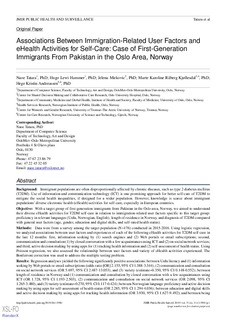| dc.description.abstract | Background: Immigrant populations are often disproportionally affected by chronic diseases, such as type 2 diabetes mellitus (T2DM). Use of information and communication technology (ICT) is one promising approach for better self-care of T2DM to mitigate the social health inequalities, if designed for a wider population. However, knowledge is scarce about immigrant populations’ diverse electronic health (eHealth) activities for self-care, especially in European countries.
Objective: With a target group of first-generation immigrants from Pakistan in the Oslo area, Norway, we aimed to understand their diverse eHealth activities for T2DM self-care in relation to immigration-related user factors specific to this target group: proficiency in relevant languages (Urdu, Norwegian, English), length of residence in Norway, and diagnosis of T2DM compared with general user factors (age, gender, education and digital skills, and self-rated health status).
Methods: Data were from a survey among the target population (N=176) conducted in 2015-2016. Using logistic regression, we analyzed associations between user factors and experiences of each of the following eHealth activities for T2DM self-care in the last 12 months: first, information seeking by (1) search engines and (2) Web portals or email subscriptions; second, communication and consultation (1) by closed conversation with a few acquaintances using ICT and (2) on social network services; and third, active decision making by using apps for (1) tracking health information and (2) self-assessment of health status. Using Poisson regression, we also assessed the relationship between user factors and variety of eHealth activities experienced. The Bonferroni correction was used to address the multiple testing problem.
Results: Regression analyses yielded the following significantly positive associations: between Urdu literacy and (1) information seeking by Web portals or email subscriptions (odds ratio [OR] 2.155, 95% CI 1.388-3.344), (2) communication and consultation on social network services (OR 5.697, 95% CI 2.487-13.053), and (3) variety (estimate=0.350, 95% CI 0.148-0.552); between length of residence in Norway and (1) communication and consultation by closed conversation with a few acquaintances using ICT (OR 1.728, 95% CI 1.193-2.503), (2) communication and consultation on social network services (OR 2.098, 95% CI 1.265-3.480), and (3) variety (estimate=0.270, 95% CI 0.117-0.424); between Norwegian language proficiency and active decision making by using apps for self-assessment of health status (OR 2.285, 95% CI 1.294-4.036); between education and digital skills and active decision making by using apps for tracking health information (OR 3.930, 95% CI 1.627-9.492); and between being a female and communication and consultation by closed conversation with a few acquaintances using ICT (OR 2.883, 95% CI 1.335-6.227).
Conclusions: This study implies immigration-related factors may confound associations between general user factors and eHealth activities. Further studies are needed to explore the influence of immigration-related user factors for eHealth activities in other immigrant groups and countries. | nb_NO |
| dc.description.localcode | © Naoe Tatara, Hugo Lewi Hammer, Jelena Mirkovic, Marte Karoline Råberg Kjøllesdal, Hege Kristin Andreassen. Originally published in JMIR Public Health and Surveillance (http://publichealth.jmir.org), 16.08.2019. This is an open-access article distributed under the terms of the Creative Commons Attribution License (https://creativecommons.org/licenses/by/4.0/) | nb_NO |

